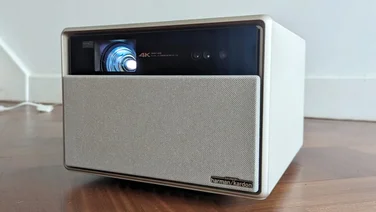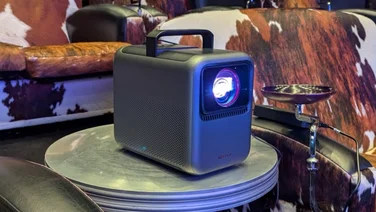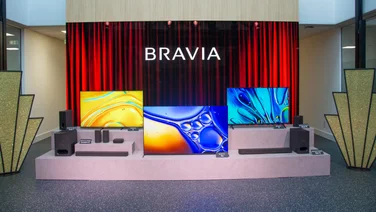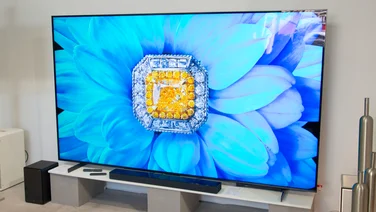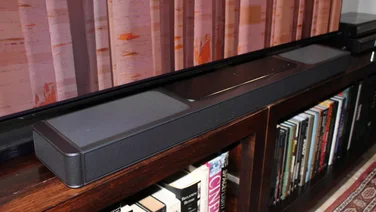To help us provide you with free impartial advice, we may earn a commission if you buy through links on our site. Learn more
- Sky Glass review: What you need to know
- Sky Glass: Key specifications
- Sky Glass review: Prices
- Sky Glass review: Design, specs and connectivity
- Sky Stream Puck review: Streaming Sky without Glass
- Sky Glass review: Software, content and features
- Sky Glass review: Remote and voice control
- Sky Glass review: Image quality
- Sky Glass review: HDR performance
- Sky Glass review: Audio
- Sky Glass review: Verdict
























- Convenient and easy to use
- Good audio quality
- HDR picture quality now quite good
- Rewind and fast-forward can be sluggish
- Fewer channels than Sky Q
Sky Glass has now been superseded by the Sky Glass Gen 2, an updated version of this TV that Sky says has better picture quality, improved audio and a refined design. You can read about the changes Sky Glass Gen 2 brings in our initial hands-on review, but essentially it’s the same proposition a streaming TV with Sky built in that you can buy either outright or spread the cost and pay monthly for.
It replaces the original Sky Glass in the range, costs exactly the same and is available to buy from 12 February 2025. In the meantime, if you’re thinking of buying Sky Glass, we’d advise holding fire until the reviews are in. Our updated review of the first Sky Glass TV is below, but be advised that the sections on picture quality and audio (and some about the design) will no longer be applicable from the above date.
Sky Glass is a big product for the UK satellite TV giant. Not only is it the first TV the company has built, its also the first time Sky has produced a streaming-only product without compromising streaming quality and features.
As such, it needs to be good. It needs to be good enough to persuade customers to ditch their old TV and trusty Sky Q box and replace them with one device that does it all. It also needs to be good enough to persuade non-Sky subscribers that this is the time to jump on board.
After a false start, its finally beginning to deliver on its promise. Sky Glass still cant quite compete with Sky Q for content and versatility, or standalone TVs and soundbars for image and audio quality, but improvements to the user interface and, most importantly, picture quality since launch have elevated it from also-ran to a genuinely attractive alternative.
Sky Glass review: What you need to know
Sky Glass isnt the only dishless Sky TV product. Since it was first launched, Sky Stream has appeared, offering the same content and user experience but without the TV attached. If you already have a decent mid-range TV and care about picture quality, this is the Sky streaming TV product you should go for.
If youre looking for a new TV now, however, and the idea of dishless Sky TV appeals, then Sky Glass is an attractive option.
The TV is available in three sizes 43in, 55in (the model we were sent) and 65in and you can buy it in five different colours (black, white, blue, green and rose gold). It has a 4K Quantum Dot panel with local dimming, and supports the HDR10, HLG and Dolby Vision HDR formats.
READ NEXT: The best TVs to buy today
It comes with a built-in Dolby Atmos soundbar that runs along the bottom and includes speakers that fire upwards. And you can use it with any broadband connection, though Sky recommends a minimum of 10Mbits/sec for HD content and 25Mbits/sec for 4K content.
Theres new Hello Sky voice control, which allows you to simply talk to the TV to control it, and you get multiroom support as well. The latter comes in the form of the oddly named Sky Stream Puck, which can deliver the same content, at the same resolution and with the same HDR support, to another TV in your house. It costs extra, though, as detailed below.

Its important to note that Sky Glass doesn’t record TV to local storage like Sky Q. Instead, users add the content they want to watch later to their Playlist, where it becomes accessible depending on the restrictions of the streaming/catchup service it first appeared on.
Its still not as flexible a system as Sky Q, where you can record any programme, watch it whenever you like and keep it on your hard disk in perpetuity.
And it remains the case that not all programmes are available to playlist in the same way they can be recorded on Sky Q. Match of the Day on a Saturday night, for example, wont appear on your Playlist until the following Monday due to rights restrictions. However, Playlist has improved since launch and you can now add more programmes than ever, including BT Sport shows.
Its also now possible to create personalised playlists one for each of the family, for instance. This doesnt work quite as well as proper profiles as your recommendations can still get polluted with other household members preferences but it works well within its limitations.
Sky Glass: Key specifications | |
| Screen sizes available: | 43in (small) 55in (medium) 65in (large) |
| Panel type: | Quantum Dot LCD with local dimming |
| Resolution: | 4K/UHD (3,840 X 2,160) |
| Refresh rate: | 60Hz |
| HDR formats: | HDR10, HLG, Dolby Vision |
| Audio enhancement: | Integrated Dolby Atmos 3.1.2 speakers |
| HDMI inputs: | 3 x HDMI 2.1 (inc 1 x eARC) |
| Freeview Play compatibility: | No |
| Tuners: | Terrestrial, streaming |
| Gaming features: | None |
| Wireless connectivity: | 802.11ax (2.4GHz and 5GHz) |
| Smart assistants: | Hello Sky |
| Smart platform: | Sky Glass |
Sky Glass review: Prices
One of the most intriguing features of Sky Glass is that you dont have to buy it like a normal TV. It comes as an addition to your Sky subscription, costing £14 per month for the 43in model, £19 per month for the 55in model or £24 per month for the £65in model, if you sign up for a 48-month contract. The monthly price doubles if you take a 24-month contract. Sky calls this a “subscription contract”, but whether you pay over 24 or 48 months, you pay no interest so you pay the same price overall.
Those with better mental arithmetic than me will have already doubtless worked out that this equates to £624, £816 or £1,008 in total (plus a £10 upfront fee for the 48-month contract or a £20 upfront fee for the 24-month contract). You can buy the TV outright from the get-go if youd prefer, but this bumps up the price slightly to £699, £949 and £1,199 (the price has risen since Glass was first launched).
























On top of this, theres a minimum Sky subscription package £26 per month for the Sky Ultimate TV package, which includes a Netflix subscription and thats before you get into the price for broadband and TV extras such as Sports and Sky Cinema.
The good news is that youre not tied into Sky Broadband; the bad news is youll be paying a bare minimum of £39 per month for the 43in TV, £43 per month for the 55in and £46 per month for the 65in. Remember, that 4K is an extra £5 per month, too, so if you want to make the most of the TV, prices start at a total of £44 per month. And, if you want multiroom, adding a Sky Stream Puck will set you back another £10 per month.
READ NEXT: The best smart TVs to buy today
Sky Glass review: Design, specs and connectivity
Sky Glass is a stylish TV a little brutalist and angular for my tastes but its tasteful nonetheless. The Dolby Atmos soundbar occupies the portion of the chassis below the display with four drivers concealed behind a fabric mesh, and a further two speakers mounted on the top edge of the TV, behind a perforated grille. Its a lot thicker than most modern TVs, measuring 49mm from front to back, and heavier, too, weighing 19kg for the 43in model, 28kg for the 55in and a back-breaking 35kg for the 65in model.
In its default configuration, it sits on a central stand with the bottom edge of the set almost flush with the surface of your AV stand, but it can also be wall-mounted, and all the hardware to do that is included in the box. Bear in mind, however, that even without the sturdy stand attached to the rear, its still a bit of a lump, with the stand-less 43in weighing 14kg, the 55in on test 23kg and the 65in 28kg. Id advise against mounting it on a plasterboard wall.
Connectivity-wise, theres not a huge amount to shout about here. You get three HDMI 2.1 inputs in a cutout on the left side of the rear, one of which supports eARC. These ports face downwards and are tricky to reach on the larger sets. In addition, theres a USB-C connector, an Ethernet port and an aerial point. You can use the latter to watch Freeview channels in the event your broadband goes down, but its only really designed as a backup to the streaming channels. It’s also worth noting that theres no 3.5mm headphone jack or Bluetooth audio connectivity. Bluetooth is used only for the remote control.

Setup is as simple as plugging it in and connecting it to your home Wi-Fi (or hooking up via Ethernet if your router happens to be close by). Unlike Sky Q, Sky Glass doesnt set up its own wireless network; it simply connects just like any wireless device. The beauty of this is that, as long as your Wi-Fi signal is strong enough and your broadband connection robust enough the only cable you need to have running to the TV is the mains cable.
Thats the theory. In practice, I had quite a bit of trouble here, at least initially. When I first received the TV for review, it repeatedly refused to recognise my Wi-Fi credentials, no matter how many times I checked, double-checked and triple-checked.
I eventually managed to connect it to my home Wi-Fi using the TVs WPS button and the same on my Devolo Magic Powerline adapter. If you come across the same issue, youll have to (rather counterintuitively) select the I have Sky Broadband option, as the third-party broadband connection option doesnt give you the choice of using WPS.
Fortunately, in the time since this review was initially published, Sky appears to have resolved this problem, at least with my wireless hardware, and I have now been able to set the TV up by selecting the network and entering a password.
Sky Stream Puck review: Streaming Sky without Glass
Although it wasnt an option at launch, Sky has now made it possible to get dishless Sky without having to buy its TV. Its called Sky Stream and its a great option for those who prefer to make their own decision about what TV to use. You can read our full review of Sky Stream here.
If you want multi-room in addition to Sky Glass, its the Sky Streaming Puck you want; its the same hardware as Sky Stream but the pricing is different. Currently, it costs an additional £12 on top of what youre already paying for the TV and your Sky subscription. It delivers the same streaming service as the TV itself (see below) at the same resolution and with the same HDR capabilities.
























The Stream Puck is a compact device with rounded corners. It has a footprint measuring 108 x 108mm and a height 18mm. It has a single status LED on the front and, at the rear, a 10/100 Ethernet port and a single HDMI 2.1 output. Theres also a coaxial antenna connector but this is disabled.
























Underneath is a power button used to reset the device in the event you lose your remote control. It comes supplied with an extra Bluetooth remote control (the same as supplied with the Sky Glass TV), and Wi-Fi connectivity is up to the same standard as well, supporting Wi-Fi 6 connections over 2.4GHz and 5GHz.
Wireless connection went without a hitch (it’s good to see those initial Wi-Fi glitches have been sorted) and I was able to select my preferred network and enter my password rather than having to go down the WPS route. After waiting a few minutes for any updates to download and install, youre almost ready to go. The only things left to do are to pair the remote with the Puck by holding the 1 and 3 buttons for three seconds, and then link the Stream Puck to your Sky account.
























Sky Glass review: Software, content and features
Assuming youre familiar with Sky Q, youll feel right at home with either Glass or the Stream Puck’s UI. The front end isnt identical but it does have the same look and feel, with the familiar blue background and all your content arranged on rails. You can navigate through these rails by clicking up and down on the remote control (see below) and explore whats in each one by clicking right and left.
The content is arranged in hierarchical order with a selection of recently viewed (click left) and promoted content items (click right) displayed in the top rail, including a thumbnail of whats currently being watched. Below this is a link to your Playlist, plus shortcuts to key overarching categories TV Shows, Movies, Sports, Kids, News, Audio and Music, Fitness and International and theres a Now and next rail underneath that, with a shortcut to a TV guide to the left of it.

Further down are a Continue watching rail, and one containing links to your HDMI-connected devices and installed apps. These are surrounded by a number of themed sections where Sky aims to promote suggested content. To access Sky Glass settings you have to scroll right down to the bottom, although most of the time its quicker to hold down the voice control button on the remote control and say Settings.
The TV guide works as you might expect it to, listing channels vertically, and you can see whats on now and in the future by navigating to the right. The list of channels isnt as extensive as it is on Sky Q but the list of apps is decent enough and covers a reasonable selection of the main providers in the UK Netflix, Amazon Prime, Disney+, Discovery+, BBC iPlayer, All4, ITVX, YouTube and Apple TV+.

The big difference between Sky Glass and Sky Q is that you cant record programmes to local storage. Instead, you click the + button to add the programme youre interested in to your Playlist, with shows that arent already available to stream (ie live TV) recorded on what Sky calls your own personal cloud DVR.
This works well, generally speaking, and has the advantage that live shows should be available instantly, whereas on other streaming products you might have to wait a while to watch them. Youll also never have to worry about running out of storage as you do with Sky Q. However, there are still some black spots such as the aforementioned Match of the Day.

Where Sky Glass cant compete with Sky Q is the responsiveness of its controls for playback and scrubbing back and forth through recorded programmes. You can pause, play and rewind just as you can with Sky Q but sometimes when you press forward wind or rewind on the remote, it takes a moment or two to catch up with what youve asked it to do. Worse, when you ask it to resume playing, it pauses instead and you often have to press the play button a few times to get going again.
On the positive side, programmes allow you to Play from start if you come in halfway through and you also get some, albeit not all, of the fancier features from Sky Qs sports channels, including the ability to catch up with highlights while youre watching.
READ NEXT: Our guide to the best TVs for gaming
Sky Glass review: Remote and voice control
The TV is supplied with a Bluetooth remote control, which is finished in the sort of soft-touch plastic that goes tacky after a while. Its backlit, which is a nice touch as it helps you find the right buttons in a darkened room. It wont help you locate the remote in the first place, however, as the backlight times out rather quickly and only turns on when you pick it up.
The layout of the remote control will be familiar to users of Sky Q. Despite the different finish, its the same shape and the buttons are largely in the same place, which is a good thing. Sky is sticking with the tried and tested here, instead of trying to reinvent the wheel, which it tried and failed to do with the disastrous Sky Q Touch Remote.

What Sky is pushing quite strongly is voice control and on Sky Glass, its built into the TV as well as the remote control. Indeed, using a far-field microphone array, Glass can detect the wake phrase Hello Sky and act on your instructions without you having to touch the remote control.
You can turn on the TV in this way, change channels, search for content and adjust the volume. Its also possible to pause, play and skip to certain points on a shows timeline with your voice, and I found it worked pretty well overall. I still found browsing the UI for things I wanted to watch easier with the remote control, though, so its best to think of Sky Glass voice control as a shortcut to common controls when you cant be bothered to pick up the remote.
One thing you might want to disable, however, is the TVs motion control sensor, which it uses to turn on the TV when you walk into the room. This might sound like a clever feature but you dont always want the TV to switch on when you walk into the room, especially with energy prices so high. I also found that, if I left the door open to the room it was in, it would also turn on when I walked past. Thats not ideal.
Sky Glass review: Image quality
At the end of 2022, Sky announced a firmware update for all Glass TVs that it said would improve picture quality. As such, weve retested the TV and have updated our findings below. It still isnt quite the best TV youll find for the money but HDR performance is now far better and colour accuracy is excellent across the board. As a result, weve upgraded Sky Glass to a four star rating with a Recommended award.
Sky Glass is a streaming package designed with convenience in mind, so its worth tempering your expectations when it comes to picture quality. The overall viewing experience delivered by its 60Hz quantum dot LED panel is far from terrible, though, Skys image quality update has improved things noticeably from a quality perspective.
One thing that hasnt changed is that youre going to want to turn off the auto backlight as soon as you get your hands on one. This power saving feature adjusts the brightness of the picture depending on the ambient light level in the room but I found it distracting.
By default, the TV also operates in Auto mode, which is supposed to adjust picture and sound settings on the fly based on what youre watching. If you want to make sure youre watching in the best possible mode for HDR or for standard dynamic range movies, however, then youll want to select your mode manually.
There are four modes available that affect image quality. Entertainment and Movie, look no different to my eyes, Sport switches you to a rather cooler colour temperature, while Vivid delivers a similar white point and more saturated colour-balance. Alas, theres low-latency Game mode but you do get a couple of audio-centric modes Music and Party to play with, which do nothing to affect the picture but instead provide preset audio settings.

Theres also the option to save your own picture settings in the Custom mode, which allows you to adjust various parameters, including contrast, video brightness, colour saturation, hue/tint, white balance, local dimming and colour temperature.
For testing colour accuracy in SDR, we tested a number of modes and found Movie mode best for overall colour performance with an average Delta E of 0.8 right up there with some of the best TVs weve tested.
Colour performance while viewing standard dynamic range content (SDR) using Movie mode colour proved decent, with Sky Glass covering 95.1% of the Rec.709 colour gamut when measured using our colorimeter and the Calman colour calibration software.
Greyscale tracking didnt miss the mark by too much either, with Sky Glass recording an average DeltaE score of 1.3 and a Gamma measurement of a fraction over 2.2. Sky Glass also scored well when it came to contrast, delivering a native contrast ratio of 5,413:1.
Despite lacking any form of viewing angle correction technology, the Sky Glass picture quality holds up well when not watched head-on. For an optimal viewing experience youll want to be looking at it relatively straight, but that experience wont differ dramatically depending on which end of the sofa youre sitting.
Sky Glass review: HDR performance
Not only is SDR performance better than it was at launch, but Sky has also improved its HDR output considerably. It still isnt the last word in HDR performance but it does now deliver convincing and enjoyable HDR picture quality.
The TVs coverage of the DCI-P3 colour gamut is now 79%, which is better but still not great. However the biggest improvements are to be seen in peak brightness. With Custom mode selected and local dimming enabled we saw peak brightness reach 804cd/m2 with a 25% patch of white in the centre of the screen and a still respectable 704cd/m2 with the standard 10% patch displayed, up from 439cd/m2 at launch.
The results now put Sky Glass in a class above budget TVs and closer, in fact, to more expensive sets such as the Sony A80J (around £999), although superior colour gamut coverage and a native 120Hz panel give that TV the edge.

That means Sky Glass is no longer the picture quality pariah it once was and is now a very good choice both for those seeking streaming convenience and decent picture quality in one well-designed package.
Sky Glass review: Audio
Audio quality remains as good as ever, although that didnt need improvement as badly as picture quality did. It isnt as good, it must be said, as if you were to connect a decent dedicated soundbar, such as the Sonos Beam 2, but better than youll get with most TVs at around the price of Sky Glass.Indeed, Sky Glass plays host to a full 3.1.2 Dolby Atmos-compatible audio system. Four drivers are housed in the soundbar part of the TV one centre speaker, one 120mm bass woofer and two stereo drivers and theres a pair of upward-firing Atmos speakers in the top corners of the TV set to deliver Atmos height effects.

Theres 215W of total amplification, too, ensuring that these deliver audio thats far more forceful than most other TVs youll encounter, with vocals and speech delivery a real strength of the system. I fired up a John Legend concert recording on Sky Arts and both the piano and Legends voice came across in a convincing and pleasing manner.
Despite all of those drivers, however, and the additional up-firing Atmos speakers, the surround-sound effect is limited. I wasnt overly impressed with the way Sky Glass delivers bass, either; even with the Bass Boost option toggled on in the settings, theres very little low-end thump and rumble.
READ NEXT: Our guide to the best TVs to buy today
Sky Glass review: Verdict
After a fairly unimpressive debut, Sky Glass has now grown into an impressive all-round package at an even more tempting price. Its convenient and easy to use, the specifications are impressive, audio quality is great (for built-in speakers) and a lot of people will be persuaded by the fact that its a relatively low-cost monthly add-on to a Sky subscription.
For those who cant or dont want to install a dish, Sky Glass is a far better option than Now, delivering all that exclusive Sky content in optimum 4K resolution. And now that image quality is fully up to snuff, you no longer have to worry about rival TVs offering significantly better output for the same or less.
Home theatre enthusiasts will still be served best by opting for an OLED TV like the Sony A80J and combining that with either Sky Q or Sky Stream and a more potent sound system.
However, as an all-in-one package, Sky Glass is now an easy TV to recommend to anyone wanting an easy life. Its a more elegant thing to have in your home than a Sky Q box, a TV and a soundbar, and picture quality is respectable as well.


